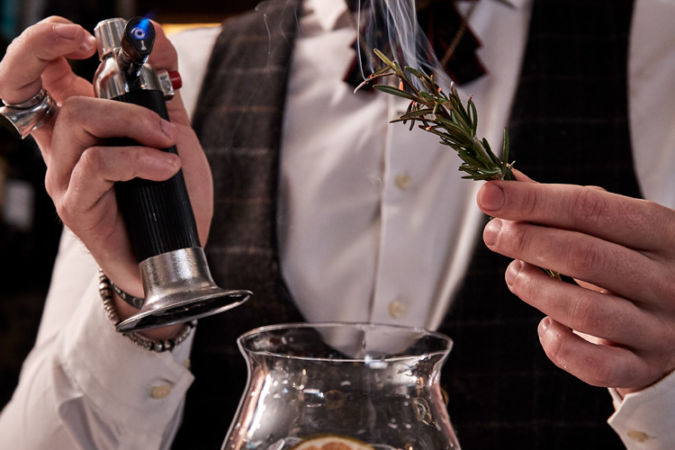Gin is a spirit in flux. It’s very difficult to understand, but perhaps you shouldn’t even try. Instead, just accept it in all its beauty and absurd complexity.
It’s impossible to have even heard of the majority of gins, let alone all of them. The world record for most gins stocked is held by a shop in York in the north of England, with 1,026. Meanwhile, at Gin Foundry we totted up a whopping 400 launches from UKbased distillers in 2018 alone, a growth that has been reflected in the staggering number of entries in awards such as the International Wine & Spirit Competition (IWSC, this magazine’s sister company), which had over 600 gins submitted in 2018. Best estimates in 2019 reckon there are about 5,000 gins produced in at least 80 countries.


It wasn’t always like this. In 2010, only a fifth of British distilleries even produced gin. Now it’s the opposite: four out of five distilleries load their stills with juniper on a regular basis.
They’re not making just one gin either. Ranges have grown from single offerings to trios and quartets. From the big players such as G&J Distillers or Sipsmith, to micro-producers like Puddingstone Distillery or Southwestern Distillery, everyone is keen to offer a broad portfolio to the promiscuous gin drinker.
Brands such as Hendrick’s helped usher in a new generation of consumers
This proliferation clearly pays dividends. Some 66 million bottles were sold in the UK last year (half as many again as the previous year); variations on “When is the gin craze going to end?” headlines appear each month in trade and national newspapers alike.


The classic gin and tonic still drives consumption in the UK. A third of all tonic water was sold in the 12 weeks to Christmas, too, proving that the fizz is being kept alive no matter the weather or the season in which it is being served.
This meteoric growth isn’t confined to the UK. Gin sales in Australia, South Africa and Japan are growing apace, with their country’s leading gins – Four Pillars, Musgrave and Ki No Bi respectively – galvanising interest in local craft offerings. Germans are getting thirstier, and Spanish demand is unquenchable. Famously, the Spaniards’ penchant for balloon glasses for G&T has caught on and is now a common sight in bars around the globe.
Quantities aside, gin is cool, too. Brands such as Hendrick’s helped usher in a new generation of consumers, with the mantle being taken on by the likes of Never Never in Australia, Iron Balls in Thailand and Aviation in the US. Whatever your style, somebody, somewhere is developing a brand for you.
If there’s a gin bubble, it’s been on the point of bursting for some years. Gin is contradicting all expectations with regards to its lifespan, and it is doing so with a panache that has not been seen in a generation. A sexy bottle glistening on a shelf is nothing new – but don’t you think the Isle of Harris Gin isn’t the most beautiful thing you’ve ever seen?


Gin has such momentum and has developed such a kaleidoscope of flavours that it’s hard to keep up. Everything’s gone a little psychedelic. Whether pineapple-flavoured or with flecks of gold suspended in the bottle, call it gin and it can coexist with the classics. A quick scroll through most online retailers will bring up Candy Cane gin, Rhubarb and Ginger, and Unicorn Tears, via Tanqueray, The Botanist, Gordon’s and Beefeater.
There are few rules. New distillers make old-fashioned juniper-forward London Drys like Dartmouth English Gin, while established giants are happy to gamble. Some are not as lurid to taste as their Pantone spectrum might suggest: try the likes of Beefeater Pink Gin, with its rosy shade backed by a healthy undertone of juniper.
Gin has developed such a kaleidoscope of flavours that it’s hard to keep up
We are also seeing a bit of fatigue setting in, and there are signs that the industry is beginning to self-regulate and dial back on the excesses of the few. But it’s a difficult balancing act – how to manage the demand for innovation without losing sight of the category’s heritage. Beefeater Pink is an example of how the big companies do it: produce something new (or newish), but make sure it harks back to a golden age – the pink gin our parents and grandparents used to drink (originally gin with Angostura bitters). It works: that gin is thought to be primarily responsible for Beefeater’s 9% growth in sales by volume between 2017 and 2018.


Still the march of gin goes on, an endless display of offerings in a multifarious variety of bottles. How can one fully understand it? The answer is to accept gin’s nature. Embrace its endless reach and approach it with the intrepid soul of an explorer. It’s the only way to fully appreciate its complexity and its interminably shifting whims.
Visit our reviews section to view our top-rated gins.





